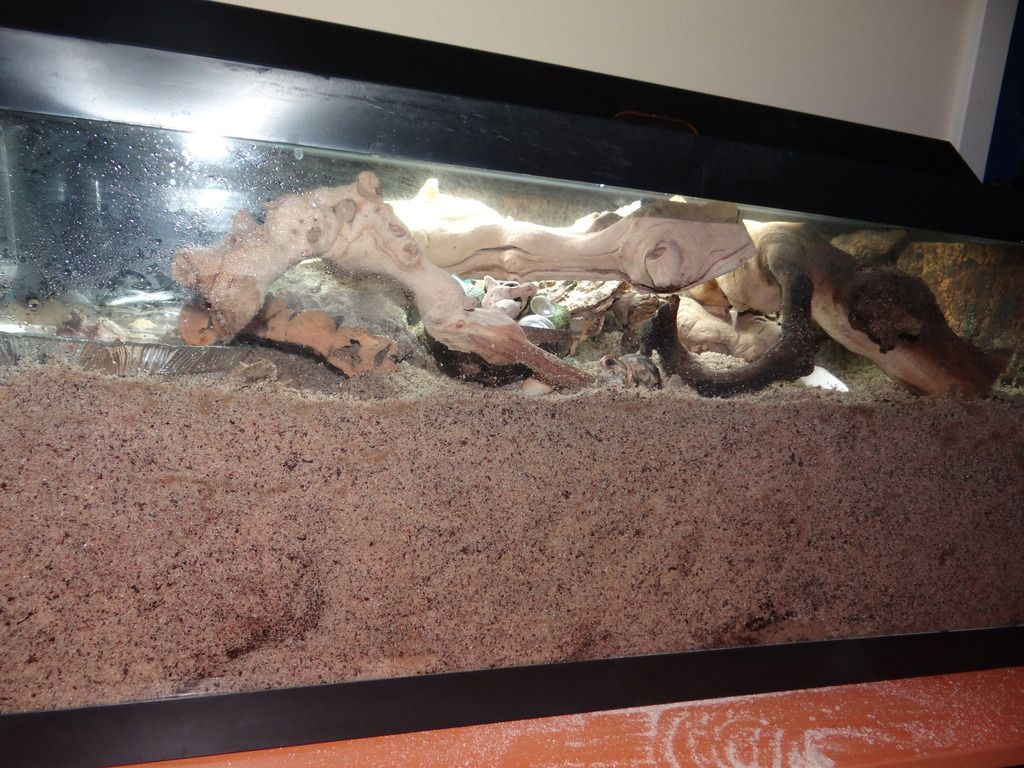kornchaser wrote:I think 4 tiny-medium crabs in a 20g (long or tall?) is fine. I do have to agree on the subject of sub though, six+ inches makes for a safer molt!! Not all crabs are aggressive, not all crabs are protein-deprived (as I see yours aren't

) ]
1) If you manage to keep them alive, they don't stay tiny, or medium, or even large. If you intend to keep them long-term, you need to plan ahead to when they are huge. (Our biggest crab went from a largish "medium" size (almost in the "large" range) to a "jumbo" in about 18 months, less than two years, for sure).
2) They don't have to be "aggressive" by tendency, or "protein-deprived," to take advantage of a vulnerable molter. It definitely helps to keep them well-stocked with sources of protein and chitin--they aren't likely to go hunting for their fellow crabs then--but if they happen upon one underground, they won't necessarily "turn up their noses" at it, so to speak.
Four crabs is enormously more problematic than two. If you already have four, that's fine, and best wishes, but if you don't, you might think seriously about stopping at just a pair, or no more than three. Here's the math demonstration I threatened earlier:
1 crab in a tank--no relationships, no interactions (not ideal, because they do like to have at least one buddy).
2 crabs--ONE relationship, one interaction pattern that could potentially cause problems (one chance of molting cannibalism, for example, or fighting over shells between two crabs). But generally, they do get familiar with each other when there are only two, and with plenty of shells and plenty of substrate, it's not an issue.
3 crabs--now you have
A with B, B with C, A with C, and all three together--
FOUR relationships/interaction patterns, not just three.
4 crabs--
A with B, A with C, A with D, B with C, B with D, C with D,
A B and C together, A B and D together, A C and D together, B C and D together, and all four together--ELEVEN relationships/interaction patterns.
5 crabs--
A with B, A with C, A with D, A with E, B with C, B with D, B with E, C with D, C with E, D with E,
A B and C, A B and D, A B and E, A C and D, A C and E, A D and E, B C and D, B C and E, B D and E, C D and E,
A B C and D, A B C and E, A B D and E, A C D and E, B C D and E, and all together--
TWENTY-SIX relationships/interaction patterns (if I didn't miss any).
See how it explodes geometrically? Each time you add just one more crab doesn't just add one more chance for something complicated to happen, it greatly multiplies it. So having just two crabs is simple, interaction-pattern-wise; there's just ONE relationship. Having 3 crabs is actually like having 4, in a way; having 5 crabs is like having 26! If you actually had 26 crabs in a tank, it would be like having a huge, huge colony, with respect to possible interactions--and when it's all compressed into an artificial environment where they don't have the safeguards and all the other limiting (and freeing) environmental factors they would naturally have in the wild, it's a recipe for potential disaster.
Now there are those here who do have large colonies (30-something or more crabs all together), usually in really huge, custom-made tanks with really deep substrate and great attention to minimizing resource aggression, but I think they would all say that they have experienced some molting disasters, for sure, and I'm pretty sure they've all had some molting attack deaths (not just injuries), as well (but correct me if I'm wrong about that, maybe not all of them have, I don't mean to overstate, but certainly some have). My point is not that nobody should ever keep a colony in a captive situation, but that, for the typical crab-keeper, more is not better. It is not better for the crabs to geometrically increase the likelihood of problematic encounters, and it's more than the typical crab-keeper really wants to get into to provide all that they need, when that many crabs get to be jumbo-sized.
Bottom line: if you really want to be able to provide the best possible captive life for the two or three crabs you have now, it's good to resist the impulse to "collect them all," and focus on providing the best you can for those few. If they could, they would thank you for it!






